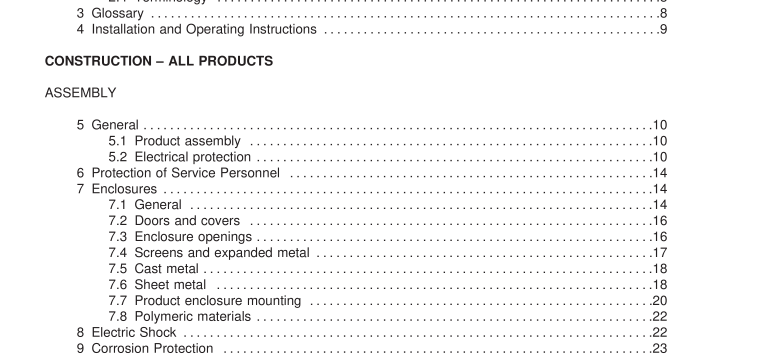UL 1037-2009 pdf download.Antitheft Alarms and Devices.
1 Scope 1 .1 These requirements apply to the construction, performance, and operation of equipment intended to provide antitheft protection. 1 .2 An antitheft alarm is intended to give both audible and visible signals or only an audible signal if theft of protected property is attempted. 1 .3 An antitheft device is intended to protect property by significantly limiting the mobility or portability of the property. 1 .4 A product that contains features, characteristics, components, materials, or systems new or different from those covered by the requirements in this standard, and that involves a risk of fire, electric shock, or injury to persons shall be evaluated using the appropriate additional component and end-product requirements to determine that the level of safety as originally anticipated by the intent of this Standard is maintained. A product whose features, characteristics, components, materials, or systems conflict with specific requirements or provisions of this Standard shall not be judged to comply with this Standard. Where appropriate, revision of requirements shall be proposed and adopted in conformance with the methods employed for development, revision, and implementation of this Standard. 2 General 2.1 Components 2.1 .1 Except as indicated in 2.1 .2, a component of a product covered by this standard shall comply with the requirements for that component. See Appendix A for a list of standards covering components generally used in the products covered by this standard. 2.1 .2 A component is not required to comply with a specific requirement that: a) Involves a feature or characteristic not required in the application of the component in the product covered by this standard, or b) Is superseded by a requirement in this standard. 2.1 .3 A component shall be used in accordance with its rating established for the intended conditions of use.
2.2 Units of measurement 2.2.1 Values stated without parentheses are the requirement. Values in parentheses are explanatory or approximate information. 2.2.2 Unless otherwise indicated, all voltage and current values mentioned in this standard are root-mean-square (rms). 2.3 Undated references 2.3.1 Any undated reference to a code or standard appearing in the requirements of this standard shall be interpreted as referring to the latest edition of that code or standard. 2.4 Terminology 2.4.1 The term ″product″ as used in this standard refers to all types of antitheft alarms and devices. 3 Glossary 3.1 For the purpose of this standard the following definitions apply. 3.2 CIRCUITS, ELECTRICAL – a) High-Voltage (Class 1 ) – A circuit involving a potential of not more than 600 volts and having circuit characteristics in excess of those of a low-voltage power-limited circuit. b) Low-Voltage – A circuit involving a potential of not more than 30 volts alternating current (AC) rms, [42.4 volts peak or direct current (DC)]. c) Power Limited – A circuit whose output is limited as specified in Power-Limited Circuits, Section 29. d) Class 2 – A circuit in which the voltage and power limitations are in accordance with the requirements of Table 29.1 for AC circuits and Table 29.2 for DC circuits. e) Class 3 – A circuit in which the voltage and power limitations are in accordance with the requirements of Table 29.1 for AC circuits and Table 29.2 for DC circuits.
4 Installation and Operating Instructions 4.1 A copy of: a) The installation and operating instructions intended to accompany each product or component as produced, b) The related schematic wiring diagrams, and c) The installation drawings is to be furnished with the sample submitted for investigation to be used as a guide in the examination and test of the product or component. For this purpose, a final printed edition is not required. 4.2 The instructions and drawings shall include at least the following: a) Typical installation drawing layouts and complete representative installation wiring diagrams for the product indicating recommended locations and wiring methods that shall be in accordance with the National Electrical Code, ANSI/NFPA 70. Locations where installations are not recommended shall also be included. b) Concise description of the operation, testing, and maintenance procedures for the product(s), and recommended testing frequency (that shall be at least once a year). c) Identification of replacement parts, such as lamps or batteries, by a part number, manufacturer’s model number, or other means that have been determined to be equivalent. d) A description of the conditions that might be expected to result in false alarms or impaired operation of the product. e) A description of any features provided to reduce the risk of fire, electric shock, or injury to persons and a warning against bypassing such features. 4.3 The instructions may be incorporated on the inside of the product, on a separate sheet, or as part of a manual. If not included directly on the product, the instructions or manual shall be referenced in the marking information on the product. See Markings – All Products, Details, Section 58.UL 1037-2009 pdf download.
UL 1037-2009 pdf download
